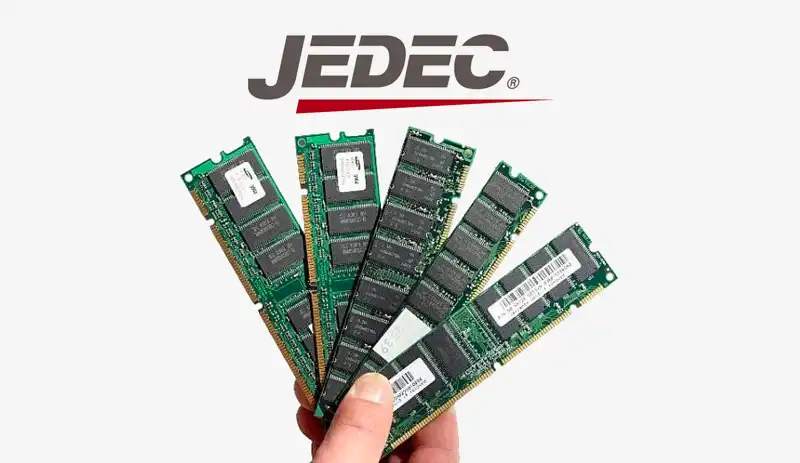You can also be interested in these:
- How industrial IoT optimizes workflows
- What is Microbenchmarking and when does it apply?
- What printer requires the less ink?
- The history of RPG and why it is beloved by many
JEDEC is a term that you have probably read several times if you have been looking through some technical articles about RAM memory, or in the specifications of certain models of main memory, etc. In this tutorial we will explain what these acronyms correspond to, and what it does in memory chips.

What is JEDEC?
JEDEC stands for the Joint Electron Device Engineering Council, which was previously known as the Solid-State Technology Association. A global industry group formed to develop open standards for microelectronics, as needed by the industry. It currently has more than 3,000 volunteer members from around the world and almost 300 member companies.
The way of working is simple. Committees are organized to propose and develop open standards, updates are published, and members meet several times a year to address changing technology needs. When a committee approves a standard, the board of directors votes on it and each member company contributes one vote.
JEDEC members include well-known industry companies such as ADATA, AMD, Ampere, Arm, Cirrus, Cisco, Dell, Ericsson, Foxconn, Fujitsu, G.Skill, HP, Micron, IBM, Infineon, Intel, LG, Marvell , Qualcomm, NEC, Nokia, NXP, Samsung, Toshiba, SK Hynix, STMicroelectronics, VIA, Western Digital, and many more.
History
JEDEC, as we know it today, was established in 1958, with the goal of focusing on vacuum tubes and semiconductors. In its inception, JEDEC was only in charge of assigning serial numbers to the different devices, but over time it became responsible for more operations, including standards development and testing methods.
Currently, memories for mobile phones and flash memories are key to JEDEC, although they are also responsible for standardizing other memories. And although not many know it, they were also responsible for developing the electrostatic discharge symbol that is now internationally known, and even published manuals of common definitions used in the semiconductor industry.
As competition in the sector has grown, JEDEC has become more important to maintain standards and compatibility between devices.
On the other hand, JEDEC has been adapting to the times as the needs of the industry change:
- 1970: JEDEC promoted standards for the military and communications industry.
- 1981: JEDEC started working in the computer space
- 1990: The automotive industry also got involved.
- 1999: An agreement was signed with the International Electrotechnical Commission and the Electronic Industries Association to make the standards available internationally.
- Present day: JEDEC have also expanded into mobile computing, the cloud, etc. They seek to cover the entire digital industry, from manufacturers to consumers. The entire chain is considered when standards are developed, from packaging, testing, quality checks and reliability.
JEDEC standards
The standards promoted by JEDEC are mainly focused in SDRAM-type memories, flash memories such as UFS, etc. These standards can be divided into three main groups:
- Flash Memory (JC-64): Flash memories have high density, low power consumption, high performance and low cost, partly, because of JEDEC. They have created several standards to cover all the necessary areas in the sector of these non-volatile memories. This includes standards for SSDs, eMMCs, and other USB flash drives, etc.
- Main memory (JC-42): There are also standards for SDRAM memory, such as DDR, in order to have higher performance, capacities, and user-friendly interfaces.
- Mobile Memory (JC-42.6): This effort focuses on memory for mobile devices, focusing standards on density, performance, and interfaces. With the development and standardization of the LPDDR and its variants, or Wide I/O, etc.
There are also other areas where JEDEC standards apply, such as memory module design, 3D-IC integrated circuit technologies, or more environmentally friendly manufacturing (lead free,…).
Benefits of open standards
The objective of JEDEC is to create common standards, as I have mentioned in the previous paragraph, which benefits:
- All the manufacturers that can make use of these non-proprietary standards.
- It also indirectly benefits consumers.
- Improves compatibility or interchangeability by avoiding misunderstandings or uncertainties.
- Help technology providers focus their efforts on R&D.
- It avoids monopolies by cornering certain dominant technologies and helps small manufacturers to compete as well.
- Avoid duplicate development efforts and promote consistency across different fields.
More stories like this
- How industrial IoT optimizes workflows
- What is Microbenchmarking and when does it apply?
- What printer requires the less ink?
- The history of RPG and why it is beloved by many
- What is Dark Silicon and what is it currently used for?
- How to protect smartphones against Pegasus virus
